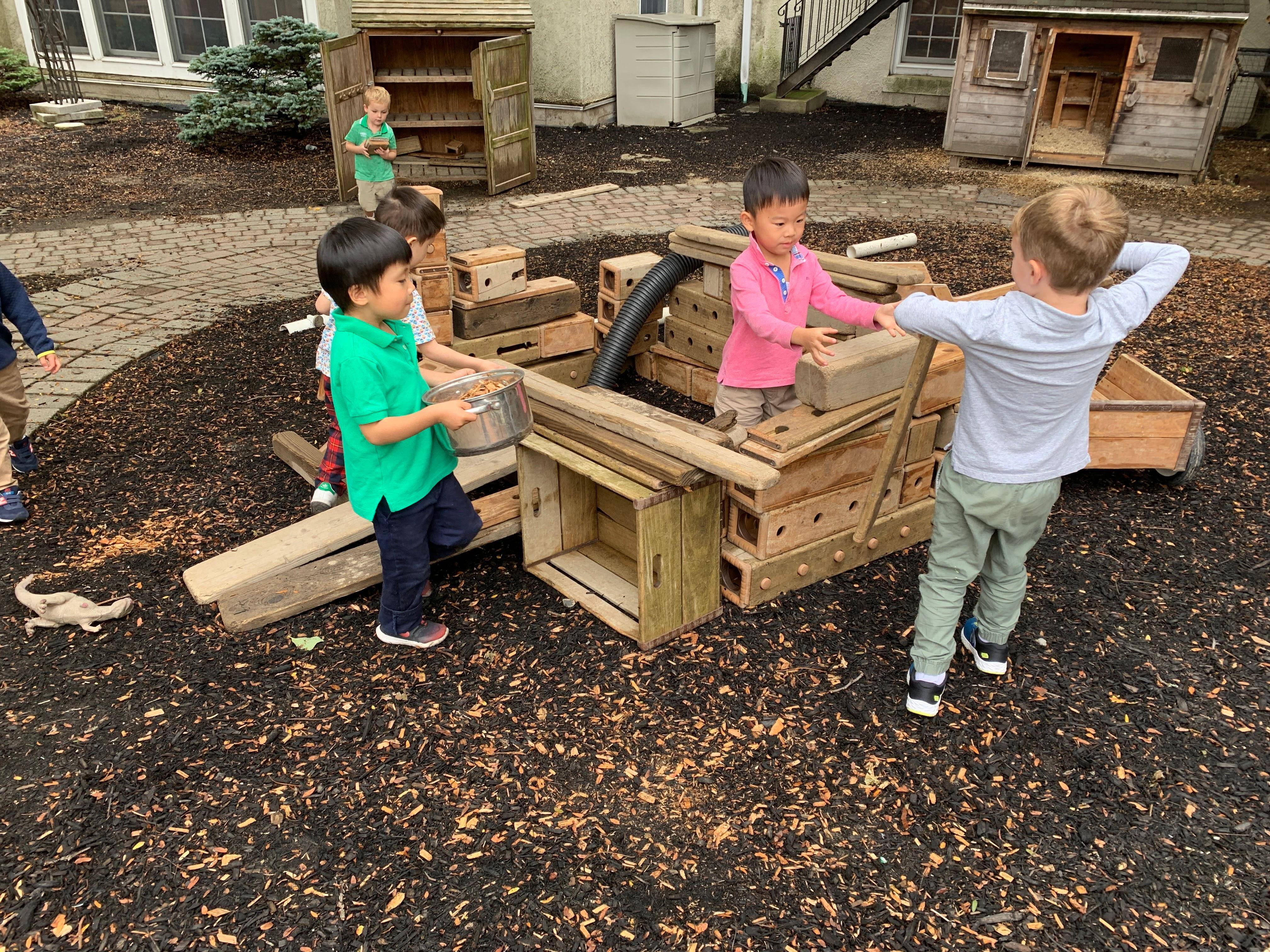Why is play so important? The value of play in providing a positive and productive learning experience can never be overstated. At the Fessenden School, active learning and play is intricately incorporated into our Pre-Kindergarten program at The Fessenden School. In this post, Craig Bouchard and Jamie Margand, two of our Pre-K teachers, explain how they facilitate learning through structured play.
Decoding the World through Play
At a young age, play is important because it's the way that children decipher and make sense of their world. “Bus stop” is a particularly popular game invented by some of our Pre-K boys that perfectly illustrates this idea. When playing “bus stop,” the boys line up along the edge of the grass on our play space and take turns waiting for a friend—the bus driver—to come by with a wheelbarrow to pick them up for their turn to ride on “the bus.” When a friend is picked up for his turn, each boy moves up one place in line until it is their turn.

While bus stop may look like all fun and games, it’s actually an active learning opportunity. Bus stop requires the boys to negotiate roles, such as who gets to be the coveted bus driver today, and teaches them the importance of patiently waiting for their turn. And, by using their bodies and words to mimic the actions and movements of a bus, they are refining their motor-skills. So in a simple game like bus stop, children are exposed to many educational factors: cooperation, social interaction, and motor-skills development, to name a few.
Ownership: An Essential Element of Play-Based Learning
While we carefully incorporate play-based learning opportunities into the curriculum each week, the boys still have a lot of choice regarding which activities they do and when they do them.
Learning through Centers Time
Each day during “Centers Time”(the part of our Pre-K program when boys visit various learning centers – science, dramatic play, construction zone, etc.), boys are encouraged to make their own play choices, while still navigating and completing any “have-to” centers (such as “Science”) that they have to visit by Friday. Ownership increases the children’s investment in their play and gives them the chance to try out different personas.
Each day during “Centers Time”(the part of our Pre-K program when boys visit various learning centers – science, dramatic play, construction zone, etc.), boys are encouraged to make their own play choices, while still navigating and completing any “have-to” centers (such as “Science”) that they have to visit by Friday. Ownership increases the children’s investment in their play and gives them the chance to try out different personas.

For example, a boy who is shy can become more outgoing when he’s given the chance to create a play scenario because he can take a leadership position. Similarly, an oldest child that is used to calling the shots at home can learn to take a back seat and let his classmates and new friends take the lead. It’s typically more difficult to explore different roles at home; the pre-K classroom gives the boys a safe environment in which they can break from the norm and take some risks.
Building a Love of Learning
Boys love to play and, while they may not know it, they learn fundamental skills by playing with others. Pre-K gives your boy the best possible introduction to school and education because we intricately weave play and learning together in a way that promotes academic development. Boys in pre-K become acclimated to the school environment in a way that enhances their appetite for learning new things, and ensures that they welcome each new school day with excitement and open minds.
For example, a more “traditional” way of teaching a boy about shapes would be to repeatedly show him a shape, such as a hexagon, reinforce verbally, “This is a hexagon,” then wait and quiz him on his ability to rename the shape. This is what is known as rote learning.
A more stimulating, play-based teaching approach may look like this: place several different shapes into a sandbox and ask the boys sort them into bins by shape. Then ask them to hold up a hexagon from the bins they’ve been sorting and ask them questions about the shape.
The objective is the same, but the latter method is a fun, hands-on experience in which the boys are learning cognitive skills, coordination, and teamwork, while at the same time coming to understand what a hexagon is. In this way, each child has the opportunity to employ his own natural learning style.
Play as a Child’s Work
For most adults “work” and “play” tend to be separate pursuits, but for children, play is their work. This concept is important at Fessenden, even to the extent of how teachers talk to the boys about their “work” in the classroom. Teachers will routinely ask to “show me what you’re working on” or “what would you like to work on today?”

When the boys are writing, they are addressed as writers. When they are building they are spoken to as architects. When in a costume during dramatic play, teachers will address a boy as “Officer Michael” or “Nurse Christopher.” We encourage our boys to see significance in everything they do, to build their confidence and to try new things.
See How They Play
A parent observing the Fessenden Pre-K program for five minutes might see it as a simple round of play, but upon closer inspection, the intended learning behind the play becomes more clear. What may seem like boys splashing around and dropping various items into our water table is revealed to be an exercise on “making predictions and observations” about which items would sink and float, and how their own thinking and predictions changed throughout the process.
.jpeg?width=561&height=748&name=Copy%20of%20YB%20Pre-K%20classroom%20unnamed%20(1).jpeg)
Every pre-K program has its own system and preferred ways of introducing boys to education. We always recommend that you visit a few schools to see which will be the best fit for your son. If you’re starting to visit schools, check out our Pre-K & Kindergarten Private School Visit Checklist, which will help you to ask the right questions to better evaluate schools.
See If Fessenden is Right For Your Child
The best way to see how important play is for your child is to take a visit and see for yourself! Explore our classrooms and our imaginative playscape to see how your child will fit in - We can’t wait to meet you!
Read On

Why Social-Emotional Development is More Important in Pre-K

Does a High-Quality Pre-K Matter? What Researchers and Teachers Say


